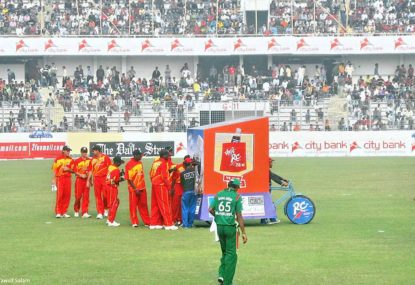Stoinis clubs stunning IPL ton, makes tough chase look a cinch with clutch final-over barrage
Marcus Stoinis produced his first IPL century and it was a beauty. He went 6, 4, 4, 4 to finish off the Lucknow Super…

Zimbabwe, previously known as Southern Rhodesia, qualified for the first time in the 1983 World Cup held in England.
They arrived at the scene with a bang. Captained by Duncan Fletcher, they upset Australia, a regular Test-playing nation with quite a bit of cricketing history behind them.
It was not the first time a regular Test-playing nation was defeated by a team qualifying for World Cup by playing a ICC tournament. It happened earlier in 1979, when Sri Lanka, then a non Test-playing nation, humiliated India.
But unlike 1979, when India was not regarded as a decent One Day side and Sri Lanka were not new to the World Cup, this victory in 1983 by Zimbabwe was considered a major upset. Australia was the connoisure of One Day cricket, regularly playing in Benson and Hedges triangular one day series at home.
Zimbabwe was a tyro, the new kid in the block, with virtually zero exposure against any quality team.
The new bloke almost repeated its feat against another side whom the skipper of their just vanquished opponent, Kim Hughes declared as the “Dark Horse” prior to the tournament. They were Kapil’s Devils with the famous tag of 40-1 outsiders, least expected to win the Cup.
No sooner than the match started, Zimbabwean bowlers Dawson and Kevin Curran ran through India’s top order like a hot knife through a slab of butter, with the score reading five down for 17, glittering that fine morning on the scoreboard at Tunbridge Wells, a sleepy small English town.
At that point, for some strange reason their captain Duncan Fletcher, took off their marauding bowler duo from the attack – a decision he would regret later, for one more wicket by their bowlers on rampage would have unsettled Indian batsmen, forever sealing India’s dream and Kim’s prediction.
When Dawson and Curran returned back later, a well set Kapil made a mincemeat of their bowling, rushing towards his record knock of 175 not put, setting up a respectable total to defend. India won the match, continuing its campaign further and later ending up winning the Cup.
India won the match, but the minnows Zimbabwe won the hearts, especially impressing all by their acrobatic fielding and spirited batting and bowling, announcing their arrival into the World Cricket scene.
Four years later in 1987, the World Cup was held in the Indian subcontinent for the first time. Led by a spirited score chase from Dave Houghton, their moustached, chain-smoking, beer-guzzling wicketkeeper, Zimbabwe almost defeated the Kiwis in a group game. It took Martin Crowe to take the catch of the tournament (adjudged the best catch in that World Cup) to grab Houghton’s wicket and prevent an improbable Zimbabwean win.
Zimbabwe continued their impressive form, eventually earning their first Test cap. I am not sure when exactly their downslide began, but most likely, it was political turmoil inside their nation which took its toll over its cricket.
Their elephant-eating (no pun, he actually feasted on an elephant on his 90th birthday), dictator Robert Mugabe did everything to take Zimbabwe into an abyss of elephantine proportion, the game being a collateral damage. He practised reverse racism, driving away the white minority, who were mostly farmers and formed the backbone of their cricket.
Imagine if he would have been white and drove away the black minority in that nation. Zimbabwe would faced severe sanctions, in the same boat as South Africa during the heydays of Apartheid, banned from all international sporting events.
It’s said that you have to carry a sack of Zimbabwean dollars to buy a bag of groceries in that nation, where cricket took a backseat as it was ravaged by severe recession. Yes, Zimbabwe continues to play Test cricket.
Yes, they still play in World Cups. Yes, they have their odd successes. But the rising and shining team, which could have followed the footsteps of Sri Lanka and Bangladesh, never rose any further and woefully stagnated. It is the sad saga of a resurgent team, who deserved a lot better.